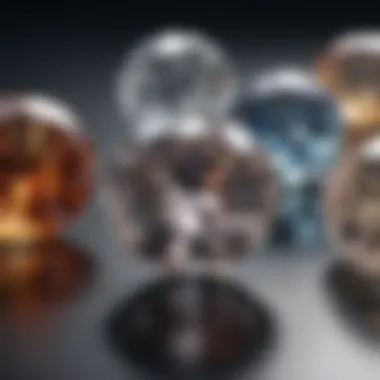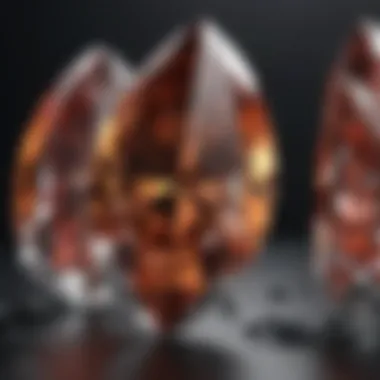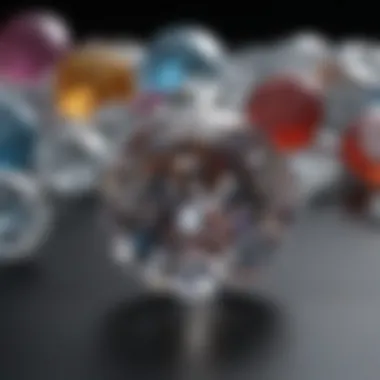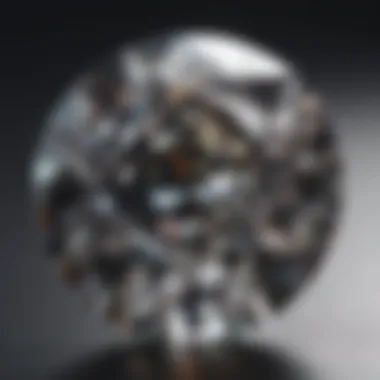Understanding the Cost of VVS Diamonds


Intro
VVS diamonds, known for their exceptional clarity, capture the attention of gemstone enthusiasts and collectors alike. This article delves into the complexities of pricing these remarkable stones, examining the factors that dictate their cost and their standing in the broader landscape of diamond grading. Understanding the nuances of VVS diamonds not only enriches one’s appreciation of these gems but also enhances informed purchasing decisions.
Gemstone Overview
Definition and Characteristics
VVS stands for Very Very Slightly Included, a clarity grade recognized in the global diamond grading system. Diamonds rated as VVS show minute inclusions that are difficult even for experienced gemologists to detect under 10x magnification. This characteristic makes VVS diamonds highly sought after, as their clarity significantly enhances their brilliance and overall beauty.
Classification of Gemstones
Gemstones can be classified into two primary categories: precious and semi-precious. VVS diamonds fall under the precious category, alongside rubies, sapphires, and emeralds. The classification stems from their rarity, desirability, and, ultimately, their market value.
- Precious gemstones: Include diamonds, rubies, sapphires, and emeralds. They are rare and often command higher prices.
- Semi-precious gemstones: Include a broader range of stones like amethysts, garnets, and topaz, generally more abundant than their precious counterparts.
The distinction between these classifications plays a vital role in the consumer market, often impacting how VVS diamonds are compared to other gemstones.
Properties of Gemstones
Physical Properties
Several physical properties contribute to the allure and value of VVS diamonds, including:
- Hardness: Diamonds have a hardness of 10 on the Mohs scale, making them the hardest known natural material. This hardness ensures durability over time.
- Transparency: VVS diamonds exhibit excellent transparency, allowing light to pass through with minimal obstruction.
- Luster: The surface of VVS diamonds reflects light beautifully, a characteristic referred to as brilliance.
Chemical Properties
Diamonds are primarily composed of carbon atoms arranged in a crystal lattice structure. This unique arrangement not only contributes to their durability but also influences how they interact with light. Key chemical properties include:
- Chemical composition: The pure form of natural diamonds is carbon, but the presence of trace elements can affect color and clarity.
- Refractive index: The refractive index of a diamond ranges from 2.42 to 2.50, significantly enhancing their luminous quality.
- Specific gravity: Diamonds have a specific gravity of about 3.5, making them denser than many other gemstones.
These properties interplay to create the distinctive nature of VVS diamonds, elevating their status in the gemstone market.
"Understanding the properties of VVS diamonds and their grading can empower buyers to make intelligent investments in these exquisite gems."
Researching market trends, as well as developing an awareness of VVS diamonds' role in the larger gemstone community, will enrich understanding and appreciation.
By appreciating their intricacies, enthusiasts can better navigate the complex world of diamond valuation, paving the way for informed and confident purchases.
Preamble to VVS Diamonds
VVS diamonds represent a specific classification of diamond clarity, known for their exceptional quality and beauty. The understanding of VVS diamonds is essential for anyone engaging in the gemstone industry, whether you are a collector, a jewelry designer, or simply someone interested in high-quality gemstones. This section serves as a foundation for comprehending the broader context of diamond pricing and the nuances that affect it.
The significance of VVS diamonds lies primarily in their clarity. Clarity, as a grading characteristic, plays a significant role in determining the overall aesthetic and value of a diamond. When enthusiasts or buyers consider VVS diamonds, they are not just looking for an attractive piece; they are investing in a well-defined standard of quality. In fact, the demand for diamonds with fewer imperfections continues to grow, making VVS diamonds increasingly sought after.
By recognizing the meaning and stature of VVS clarity, readers can better appreciate what distinguishes these diamonds from others in the market. Understanding this will also provide deeper insights into how clarity impacts cost, thereby enhancing overall investment strategies in diamond purchasing.
Definition of VVS Diamonds


VVS stands for "Very Very Slightly Included." This designation is part of the Gemological Institute of America (GIA) grading scale, which ranks diamonds based on clarity. VVS diamonds have inclusions that are only detectable under magnification. Their beauty is often described as flawless to the naked eye, offering a pristine appearance. This level of clarity indicates that the diamond is of superior quality compared to others with noticeable flaws.
The VVS grade is further split into two subcategories: VVS1 and VVS2. VVS1 diamonds possess inclusions that are smaller and less visible than VVS2 diamonds. The distinction, though subtle, can significantly affect both market value and buyer preferences.
Importance of Clarity in Diamonds
Clarity remains one of the key factors affecting a diamond's allure and value. Diamonds with higher clarity ratings not only appear more transparent but also display superior brilliance and fire. These attributes contribute to the overall desirability of the stone. Clarity, therefore, is not just a matter of aesthetics; it is fundamentally intertwined with the quality of the gemstone.
Understanding clarity as a measure helps potential buyers evaluate the value for money in their purchases. A VVS diamond usually commands a higher price compared to stones with lower clarity grades, due entirely to its superior visual properties.
- Clarity plays a crucial role in determining:
- Sparkle and brilliance of the stone.
- Market value.
- Overall aesthetics and beauty.
Investors and collectors alike should take into account these elements when navigating the complexities of diamond pricing.
"A VVS diamond, while not flawless, provides an excellent balance between quality and cost, making it a preferred choice for luxury lovers."
Factors Influencing the Price of VVS Diamonds
Understanding the factors that influence the price of VVS diamonds is essential for anyone looking to purchase or invest in high-quality gemstones. Each element contributes to the overall value and desirability of these diamonds. Engaging in this analysis can help buyers make informed decisions, ultimately ensuring satisfaction with their investment.
Cut Quality
The cut quality of a diamond significantly impacts its appearance and therefore its price. A well-cut VVS diamond will reflect light beautifully, enhancing its brilliance and fire. Factors such as proportions, symmetry, and polish all play critical roles. Diamonds that are cut too deep or too shallow can lose light and sparkle. Hence, buyers should pay attention to the cut quality, as it directly correlates with visual appeal and market value.
Color Grade
Color grade is another crucial aspect influencing the price of VVS diamonds. Diamonds are graded on a scale from D (colorless) to Z (light yellow or brown). VVS diamonds typically fall within the D to J range. The less color a diamond has, the more valuable it is. Buyers prefer diamonds that are closer to colorless, as they are rare and sought after. Understanding the color grade helps buyers ascertain the worth of the diamond they consider.
Carat Weight
Carat weight refers to the size of the diamond. Generally, the larger the stone, the higher the price per carat. However, the relationship between size and value is not linear. For instance, while a one-carat VVS diamond may cost less per carat than a two-carat one, the increase in value is often substantial. Therefore, buyers must balance their preference for size with their budget constraints, as larger stones can represent a significant investment.
Market Demand and Supply
Market demand and supply dictate the pricing landscape for VVS diamonds. Economic factors, trends in consumer behavior, and seasonal demand all play a role. When demand outstrips supply, prices inflate. Conversely, if supply exceeds demand, prices may decline. It is crucial for potential buyers to remain informed about market trends. They should consider historical price data to make the best purchasing decisions.
Brand Influence
The brand associated with a VVS diamond can greatly affect its price. Well-established brands, such as Tiffany & Co. or Cartier, often command higher prices due to their reputation for quality and craftsmanship. Consumers frequently pay a premium for the assurance of purchasing from a recognized brand. Thus, buyers need to evaluate whether the brand presence is worth the additional cost, based on their needs and expectations.
VVS diamonds represent a significant financial commitment, where each factor influencing price plays an essential role. By carefully analyzing cut quality, color grade, carat weight, market conditions, and brand influence, potential buyers can navigate the complexities of acquiring a quality diamond.
Comparative Analysis of Diamond Clarity Grades
The clarity of a diamond is a crucial factor in its valuation. Understanding the different clarity grades helps in making informed decisions, whether for personal purchase or investment purposes. The comparative analysis of these grades allows buyers to see the distinctions and choose wisely according to budget and preference. In this section, we will explore how VVS diamonds differ from other classifications, particularly SI and IF diamonds, and how visual differences play a role in their appeal and price.
Comparison with SI and IF Diamonds
VVS diamonds, characterized by their very slight inclusions, hold a unique position within the clarity scale, standing between SI (Slightly Included) and IF (Internally Flawless) diamonds. The classification system for diamonds ranges from Flawless (FL) to Included (I), with VVS falling just below IF. When comparing VVS diamonds to SI diamonds, the differences become apparent.


- Inclusions:
- Value:
- Market Appeal:
- VVS diamonds have microscopic inclusions that are difficult for even a trained gemologist to detect without magnification.
- In contrast, SI diamonds contain visible inclusions that can be seen without magnification, which significantly impacts their overall clarity and value.
- VVS diamonds typically command higher prices due to their superior clarity. SI diamonds are more affordable, but the presence of noticeable inclusions diminishes their desirability.
- VVS diamonds are sought after for their near-flawless appearance. They appeal to collectors and those valuing exceptional quality.
- SI diamonds may attract budget-conscious buyers who still desire a diamond but are willing to compromise on clarity.
VVS and IF diamonds share high quality, but the mere presence of slight inclusions in VVS diamonds is what sets them apart from the completely flawless characteristic of IF diamonds. Thus, understanding these differences not only enhances the appreciation for each grade but also aids in making wise purchasing decisions.
Visual Differences in Clarity
A fundamental aspect of diamond grading is the visual representation of clarity grades. This aspect holds particular significance when consumers seek to choose diamonds based on aesthetics. The visual differences among VVS, SI, and IF diamonds can impact personal preference and market value.
- VVS Diamonds: These diamonds present a brilliant and clear appearance. Under standard viewing conditions, the inclusions are nearly imperceptible, which contributes to their visual allure. Their clarity creates a shimmering effect, making them ideal for high-end jewelry.
- IF Diamonds: Known for being internally flawless, these diamonds have no inclusions visible even under magnification. They exhibit a superior visual quality that attracts those seeking perfection.
- SI Diamonds: The visible inclusions in SI diamonds can detract from their brilliance. Depending on the type and location of inclusions, they may impact light return, leading to a less vibrant appearance.
In summary, visual differences in clarity grades not only affect the aesthetic appeal but also play a significant role in market demand and pricing.
"Understanding the distinctions between VVS, SI, and IF diamonds allows buyers to appreciate the nuances in clarity that inform their buying decisions."
By grasping the comparative factors in diamond clarity grades, individuals are better equipped to choose the right diamond based on their personal values and financial considerations.
Current Market Trends for VVS Diamonds
Understanding the current market trends for VVS diamonds is crucial for anyone looking to invest in these precious stones. The market for VVS diamonds reflects broader economic conditions, consumer preferences, and emerging trends in sustainability and ethical sourcing. Observing these trends can provide significant insights into the future value of VVS diamonds, guiding buyers and investors alike.
Price Trends Over Time
Price trends for VVS diamonds have shown fluctuations influenced by various factors. Historical data indicate that the demand for VVS diamonds has generally increased over the past decades, although economic downturns can cause temporary declines in prices. Recent years have seen a surge in consumer awareness regarding diamond quality and clarity, leading to a greater appreciation for VVS diamonds.
- Increasing Demand: More buyers understand the nuances of diamond grading, which has raised the profile of VVS diamonds compared to lower clarity grades.
- Global Events Impact: Economic events, such as the COVID-19 pandemic, have affected supply chains, influencing prices significantly. During periods of instability, buyers may gravitate towards high-quality diamonds, which tend to hold value better.
"Understanding diamond pricing dynamics is essential for making informed purchasing decisions."
The price of VVS diamonds is not static. Buyers should consider historical pricing trends when examining potential purchases. Additionally, the rarity of VVS diamonds contributes to their high value, demanding close monitoring of market availability and fresh inventory.
Regional Price Variations
Regions also play a significant role in the pricing of VVS diamonds. Different countries and cities can exhibit considerable price variations based on local demand, economic conditions, and cultural values associated with diamond purchasing. Some key factors to consider include:
- Geographical Demand: In regions where luxury spending is more common, such as major metropolitan areas, prices can be higher due to competition among buyers.
- Local Economy: The economic stability of a region affects purchasing power, influencing how much consumers are willing to spend on VVS diamonds.
- Cultural Preferences: Different cultures may place varying degrees of importance on diamond ownership, thereby affecting market dynamics. For example, in places like the Middle East or Asia, there might be a more prominent demand for conspicuous luxury items.
Investors and collectors should always conduct thorough market research when considering purchases across various regions. This can lead to better opportunities and insights regarding potential value appreciation over time as market dynamics evolve.
Ethical Considerations in Diamond Pricing
Understanding the ethical considerations surrounding diamond pricing is vital in comprehending the overall value of VVS diamonds. Ethical sourcing has gained prominence in recent years, as consumers increasingly seek to support products aligned with their values. This growing awareness has significant implications for the diamond market. The emphasis on ethics not only influences consumer preferences but also informs industry practices.
The factors at play include the impacts of conflict diamonds and the importance of sustainable sourcing practices.
Conflict Diamonds Impact


Conflict diamonds, also known as blood diamonds, are gemstones mined in war zones and sold to finance armed conflict against governments. This phenomenon raised serious ethical concerns about the diamond industry. The illicit trade of these diamonds often occurs in countries where human rights abuses are prevalent. These practices have tarnished the reputation of diamonds in general, including those with flawless clarity like VVS diamonds.
The impact of conflict diamonds extends beyond simple ethical concerns. It shapes market dynamics. Awareness of the potential origins of diamonds can lead consumers to avoid purchasing stones that lack verified, ethical certifications. As a result, many diamond retailers now place emphasis on sourcing from conflict-free zones.
A key commitment was made globally through the Kimberley Process in 2003 to ensure that trade in rough diamonds does not fund violence. However, the effectiveness of this process has been questioned. Reports of conflict diamonds still making theirway into the market pose challenges in establishing consumer trust. Consumers must therefore be vigilant when selecting diamonds, ensuring that the stones they consider are certified to be conflict-free.
"Ethical sourcing aligns more closely with modern consumer values, influencing choices in the diamond market."
Sustainable Sourcing Practices
Sustainable sourcing practices represent a positive shift in how diamonds are obtained and traded. With an increasing focus on environmental and social impacts, these methods promote responsible mining practices that benefit communities involved in diamond extraction. Sustainable practices also ensure that the impact on nature is minimized and that local populations receive fair compensation.
For VVS diamonds, knowing how the diamond was sourced can greatly affect its value. Diamonds that are sourced sustainably are often marketed at a premium, reflecting their increased desirability among ethically-minded consumers. Jewelers like Brilliant Earth highlight their commitment to offering only ethically sourced diamonds. They emphasize transparency about the origins of their products, allowing buyers to feel secure in their investment.
Moreover, supporting brands that prioritize sustainable practices can drive positive change within the industry.
In summary, ethical considerations in diamond pricing are critical in today’s marketplace. Understanding the implications of conflict diamonds and promoting sustainable sourcing helps cultivate a more ethical diamond industry. As consumers become more informed, retailers may adjust their practices accordingly, ultimately enhancing the value and appeal of VVS diamonds.
Investing in VVS Diamonds
Investing in VVS diamonds represents a unique opportunity for individuals seeking both beauty and value. These diamonds, recognized for their high clarity, serve not only as stunning pieces of jewelry but also as tangible assets. Understanding why VVS diamonds hold value can help potential investors make informed decisions.
Investment Potential of High-Quality Diamonds
High-quality diamonds, particularly VVS diamonds, have long been regarded as sound investments. The exceptional clarity of VVS diamonds places them in a desirable category among gemstones. Investors often look for attributes such as rarity, aesthetic appeal, and market demand, all of which VVS diamonds possess.
- Rarity: VVS diamonds are rare, with clarity graded as 'Very Very Slightly Included.' This makes them more sought after than diamonds with lower clarity ratings. Their scarcity can drive prices higher, making them a potentially profitable investment.
- Aesthetic Appeal: The visual beauty of VVS diamonds cannot be overstated. Their clarity allows light to pass through without significant interference, enhancing their brilliance. This characteristic ensures that they remain attractive in the eyes of collectors and jewelry enthusiasts alike.
- Market Demand: The demand for high-quality diamonds tends to remain strong, even amid economic fluctuations. Collectors and investors view them as valuable assets that can appreciate over time.
Beyond these factors, investing in VVS diamonds presents some risks worth considering. Market fluctuations can affect diamond prices, and unlike stocks or bonds, diamonds are not liquid assets. Therefore, potential investors should approach acquisitions with careful consideration.
Preserving Value Over Time
Preserving the value of VVS diamonds requires strategic management and an understanding of market trends.
- Proper Care: Keeping diamonds in optimal condition is crucial. Regular cleaning and safe storage can help maintain their luster and prevent physical damage, ensuring they remain desirable for resale.
- Market Awareness: Staying informed about market trends is essential. Fluctuations in the economy or changes in consumer preferences can impact diamond values. Investors who keep an eye on market dynamics will be better positioned to make timely decisions.
- Certificates and Grading Reports: Investing in VVS diamonds with reputable grading can enhance their resale value. Certificates from recognized organizations, such as the Gemological Institute of America (GIA), provide assurance of quality and authenticity, making these diamonds more appealing to potential buyers.
"Investing in VVS diamonds combines appreciation of beauty with financial acumen. As long as the investment is approached with care, potential returns can be significant."
Ultimately, VVS diamonds should be viewed not solely as investments but also as cherished pieces that can inspire joy. When chosen wisely and looked after properly, they can offer both aesthetic pleasure and financial benefits over time.
Culmination and Future Outlook
Summary of Key Points
To summarize, several key points emerge from our discussion:
- VVS diamonds are valued for their exceptional clarity, making them a sought-after choice.
- The price of VVS diamonds is influenced by factors such as cut quality, color grade, carat weight, and market demand.
- Demand for ethical sourcing has become increasingly important, shaping market behavior.
These elements collectively illustrate the intricacies involved in the pricing of VVS diamonds, guiding buyers and investors alike.
Future Trends in VVS Diamond Pricing
Looking ahead, the diamond market may experience several noteworthy trends for VVS diamonds. Firstly, increasing consumer awareness surrounding ethical sourcing practices may drive prices. Buyers are becoming more selective, opting for diamonds that adhere to sustainable practices, which may set a new standard for pricing.
Secondly, advancements in technology, such as lab-grown diamonds, may influence market dynamics. As more consumers become educated about their value, there may be shifts in choice between natural and synthetic options. Thus, regular monitoring of market changes is essential for stakeholders.
Lastly, the appreciation for unique characteristics and personalization may become more pronounced. Consumers will likely value distinct features, influencing prices positively for diamonds that stand out. Those following these trends will be better equipped to invest wisely in VVS diamonds and navigate the evolving marketplace.



